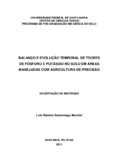| dc.creator | Montiel, Luis Ramiro Samaniego | |
| dc.date.accessioned | 2017-03-30 | |
| dc.date.available | 2017-03-30 | |
| dc.date.issued | 2011-08-31 | |
| dc.identifier.citation | MONTIEL, Luis Ramiro Samaniego. Soil phosphorus and potassium levels budget and temporal evolution farming management areas. 2011. 135 f. Dissertação (Mestrado em Agronomia) - Universidade Federal de Santa Maria, Santa Maria, 2011. | por |
| dc.identifier.uri | http://repositorio.ufsm.br/handle/1/5540 | |
| dc.description.abstract | The need for improving nutrient use efficiency and increase savings demand a better
knowledge of soils and production systems. The objective of this study was to
evaluate the soil P and K budget and its relationships with their temporal evolution on
site-specific management areas. The experiments were carried out in four cropland
areas from the Medium Plateau region of the Rio Grande do Sul state, located at the
cities of Almirante Tamandaré do Sul, Tio Hugo, Não-Me-Toque and Vitor Graeff.
Soil tests were used to verify the spatial variability, budget and temporal evolution of
soil P and K levels by the comparison of the years of 2005 and 2009. Regression
analysis was performed by the software JMP IN v.3.2.1 to evaluate the relationship
between P and K budget and the temporal evolution of soil P and K levels. Cropland
areas showed high spatial variability for P and K soil test levels at the beginning of
the study, which was decreased by applying precision farming techniques.
Relationships between P and K budget and the temporal evolution of soil P and K
test levels were positive with the exception of the Vitor Graeff area which showed
negative P and K budget. P and K fertilization were 30 and 25% higher in relation to
their exportation, respectively. On average, soybean extracted 44 kg P2O5 ha-1 and
63 kg K2O ha-1, while the maize exported 78,5 kg P2O5 ha-1 and 59 kg K2O ha-1.
Temporal evolution of soil P and K test levels was high when P and K budget was
low and there was a low temporal evolution when the P and K budget was high. On
the average of the four cropland areas there were necessary the input of 12,0 kg
P2O5 ha-1 to increase 1 mg dm-3 of soil P test levels and the input of 4,1 kg K2O ha-1
to increase 1 mg dm-3 of soil K test levels. | eng |
| dc.format | application/pdf | por |
| dc.language | por | por |
| dc.publisher | Universidade Federal de Santa Maria | por |
| dc.rights | Acesso Aberto | por |
| dc.subject | Agricultura de precisão | por |
| dc.subject | Variabilidade do solo | por |
| dc.subject | Balanço de nutrientes | por |
| dc.subject | Precision farming | eng |
| dc.subject | Soil spatial variability | eng |
| dc.subject | Nutrient budget | eng |
| dc.title | Balanço e evolução temporal de teores de fósforo e potássio no solo em áreas manejadas com agricultura de precisão | por |
| dc.title.alternative | Soil phosphorus and potassium levels budget and temporal evolution farming management areas | eng |
| dc.type | Dissertação | por |
| dc.description.resumo | A necessidade de aproveitar melhor os insumos e economizá-los na maior medida
possível leva à obrigação de conhecer a fundo os solos e sistemas de produção. O
objetivo deste trabalho foi avaliar o balanço nutricional de fósforo (P) e potássio (K)
no solo e sua relação com a evolução temporal, em áreas manejadas com auxilio da
agricultura de precisão. Os experimentos foram conduzidos no Planalto Médio do
Rio Grande do Sul, em quatro áreas situadas nos municípios de Almirante
Tamandaré do Sul, Tio Hugo, Não-Me-Toque e Vitor Graeff. Por meio da análise das
amostras de solo foi verificada a evolução dos teores de P e K comparando os anos
de 2005 a 2009. Análises de regressão realizadas pelo software JMP IN v.3.2.1
foram utilizadas para avaliar a relação entre saldo e evolução de P e K.
Determinaram-se a variabilidade espacial, o balanço nutricional e a evolução
temporal de P e K no solo. As áreas apresentaram no inicio do estudo uma grande
variabilidade espacial, as quais foram reduzidas mediante uso de práticas de
agricultura de precisão. As relações entre os saldos e as exportações foram
positivas em todos os locais com exceção da área situada em Vitor Graeff onde
também se obtiveram saldos negativos. As fertilizações fosfatadas e potássicas
foram 30 e 25 % superiores em relação as exportações, respectivamente. A soja
extraiu em média 44 kg ha-1 de P2O5 e 63 kg ha-1 de K2O já o milho exportou 78,5 kg
ha-1 de P2O5 e 59 kg ha-1 de K2O. A evolução dos teores foi alta quando os saldos
eram baixos e, baixa quando o saldo se encontrava em níveis altos. Em média para
os quatro locais foram necessários aplicar 12,0 kg ha-1 de P2O5 para elevar 1 mg dm-
3 de P no solo, assim como 4,1 kg ha-1 de K2O para elevar 1 mg dm-3 de K no solo. | por |
| dc.contributor.advisor1 | Amado, Telmo Jorge Carneiro | |
| dc.contributor.advisor1Lattes | http://lattes.cnpq.br/8591926237097756 | por |
| dc.contributor.referee1 | Fiorin, Jackson Ernani | |
| dc.contributor.referee2 | Santi, Antônio Luis | |
| dc.contributor.referee2Lattes | http://lattes.cnpq.br/6223011493102530 | por |
| dc.creator.Lattes | http://lattes.cnpq.br/3601969753058000 | por |
| dc.publisher.country | BR | por |
| dc.publisher.department | Agronomia | por |
| dc.publisher.initials | UFSM | por |
| dc.publisher.program | Programa de Pós-Graduação em Ciência do Solo | por |
| dc.subject.cnpq | CNPQ::CIENCIAS AGRARIAS::AGRONOMIA::CIENCIA DO SOLO | por |


